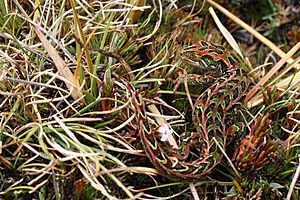Harlequin gecko facts for kids
- For the distinctive type of paneling from New Zealand, see Tukutuku
Quick facts for kids Harlequin gecko |
|
|---|---|
 |
|
| Conservation status | |
| Scientific classification | |
| Genus: |
Tukutuku
|
| Species: |
rakiurae
|
 |
|
| Distribution map of Tukutuku rakiurae on Stewart Island. | |
| Synonyms | |
|
|
The harlequin gecko (Tukutuku rakiurae) is a special type of gecko. It is a small lizard that belongs to the Diplodactylidae family. This gecko is found only in one place: Stewart Island/Rakiura in the very south of New Zealand.
Scientists first discovered the harlequin gecko in 1969. It lives in one of the southernmost places on Earth for any gecko species. This makes it quite unique!
Contents
What's in a Name?
The name Tukutuku comes from the Māori word for a special kind of woven wall panel. These panels have beautiful patterns. The harlequin gecko's back has patterns that look a lot like these traditional Māori designs.
The second part of its name, rakiurae, also comes from Māori. It refers to Rakiura, which is the Māori name for Stewart Island. So, its name tells us about its patterns and where it lives!
Where Do Harlequin Geckos Live?
Harlequin geckos prefer to live in certain types of places. Their favorite homes are areas with shrubs and wetlands. These habitats provide them with shelter and food.
Life Cycle and Reproduction
The harlequin gecko is a viviparous animal. This means that, unlike many other reptiles that lay eggs, the mother gecko gives birth to live young. The baby geckos develop inside the mother's body until they are ready to be born.
How Are They Protected?
The harlequin gecko is a special creature, and efforts are made to protect it. In 2012, the Department of Conservation (DOC) in New Zealand classified the harlequin gecko as "Nationally Vulnerable." This means that while it's not in immediate danger of disappearing, its population is small and needs careful watching to make sure it stays safe for the future.


